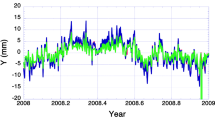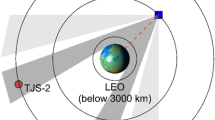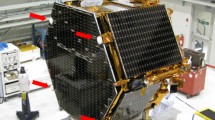Summary
Carrier phase measurements are potentially the most precise observations available from theGPS satellite system, the formal precision being of the order of one centimeter per observation. If the so called double differences are used as the basic observable, the analysis is relatively simple, since satellite- and receiver-clocks may be represented by basic models. We investigate the feasibility of double difference phase observations for orbit determination using the material of the 1985 High Precision Baseline Test, where the coordinates of the so called fiducial points (Haystack, Ft. Davis Richmond and Mojave) are held fixed.TI-4100 andAFGL-receiver observations were used in the same orbit determination process.
Although no surface weather data had been available to us, the orbit quality seems to be of the order of0.1 ppm. When we use these orbits to estimate the coordinates of the five “non-fiducial points” Owens Valley, Hat Creek Mammoth Lake, Austin and Dahlgren we get a repeatability of the order of5 cm for latitude and longitude and10 cm for height, if the observations of the first four days of the campaign are compared to those of the second four days.
If we use our orbits estimated withTI andAFGL observations to process the Mojave—Owens Valley baseline (length245 km) measured by the twoSERIES-X receivers, we obtain day to day repeatabilities of1.6 cm (0.06 ppm) in length,2 cm (0.08 ppm) in latitude,4 cm (0.16 ppm) in longitude and7 cm (0.29 ppm) in height.
Since there are indications that regional networks will be realized in the near future, the results presented here should encourage the realization of regional high precision orbit determination services.
Similar content being viewed by others
References
R.I. ABBOT, Y.BOCK, C.C. COUNSELMAN III, R.W.KING, S.A. GOUREVITCH, B.J. ROSEN (1985): “Interferometric Determination of GPS Satellite Orbits.” First International Symposium on Precise Positioning with the Global Positioning System, Rockville, 1985.
R.I. ABBOT Y. BOCK, C.C. COUNSELMAN III, R.W. KING (1985): “GPS Orbit Determination.” Fourth International Geodetic Symposium on Satellite Positioning, Austin, Texas, USA, 28 April–2 May 1986.
G. BEUTLER (1984): “GPS Carrier Phase Difference Observation Software.” Technical Memorandum TM-2, Dept. of Surveying Engineering, University of New Brunswick, P.O. Box 4400, Fredericton, N.B., Canada E3B 5A3.
G. BEUTLER, W. GURTNER, I. BAUERSIMA, R. LANGLEY (1985): “Modeling and Estimating the Orbits of GPS Satellites.” First International Symposium on Precise Positioning with the Global Positioning System, Rockville, 1985.
G. BEUTLER, J. GERVAISE, W. GURTNER, M. MAYOUD (1985): “Test of GPS on the CERN-LEP Control Network.” Proceedings of the Joint Meeting of FIG Groups 5b and 5c on Intertial, Doppler and GPS Measurements for National and Engineering Surveys, July 1985, Munich.
W. GURTNER (1985): “GPS-Papers presented by the Astronomical Institute of the University of Berne in the Year 1985.” Mitteilungen der Satelliten-Beobachtungsstation Zimmerwald, Nr. 18.
R.R. STEEVES, D. DELIKARAOGLOU, N. BECK (1986): “Development of a Canadian Active Control System using GPS.” Fourth International Geodetic Symposium on Satellite Positioning, Austin, Texas, USA, 28 April–2 May 1986.
T. SCHILDKNECHT (1986): “The Contribution of GPS Pseudorange Registrations to the Evaluation of Carrier Phase Observations.” Mitteilungen der Satelliten-Beobachtungsstation Zimmerwald. In preparation.
W. GURTNER, G. BEUTLER, I. BAUERSIMA, T. SCHILDKNECHT (1985): “Evaluation of GPS Carrier Difference Observations: The Bernese Second Generation Software Package.” First International Symposium on Precise Positioning with the Global Positioning System, Rockville, 1985.
H.F. FLIEGEL, W.A. FEES, W.C. LAYTON, N.W. RHODUS (1985): “The GPS Radiation Force Model.” First International Symposium on Precise Positioning with the Global Positioning System, Rockville, 1985.
G. BEUTLER, D.A. DAVIDSON, R. LANGLEY, R. SANTERRE, P. VANICEK, D.E. WELLS (1984): “Some Theoretical and Practical Aspects of Geodetic Positioning using Carrier Phase Difference Observations of GPS Satellites.” Mitteilungen der Satelliten-Beobachtungsstation Zimmerwald, Nr. 14 and Department of Surveying Engineering Technical Report No. 109, University of New Brunswick, Fredericton, Canada.
M. ROTHACHER, G. BEUTLER, W. GURTNER, A. GEIGER, H.G. KAHLE, D. SCHNEIDER (1986): “The 1985 Swiss GPS-Campaign.” Fourth International Geodetic Symposium on Satellite Positioning, Austin, Texas, USA, 28 April–2 May 1986.
P.M. KROGER (1986): “A priori locations of sites occupied during the March 1985 GPS High Precision Baseline Test.” Inter-office Memorandum, Jet Propulsion Laboratory, 14 July 1986.
G. BEUTLER, W. GURTNER, M. ROTHACHER, T. SCHILDKNECHT, I. BAUERSIMA (1986): “Using the Global Positioning System (GPS) for high precision geodetic surveys: highlights and problem areas.” Submitted to IEEE Transactions.
J.M. DAVIDSON, C.L. THORNTON, S.A. STEPHENS, J.S. BORDER, O.J. SOVERS, S.M. LICTEN (1986): “Improved application of the fiducial concept for GPS-based geodesy.” EOS Transactions AGU, 67, 262, 1986.
Y. BOCK, R.I. ABBOT, C.C. COUNSELMAN, R.W. KING (1986): “A demonstration of 1–2 parts in 107 accuracy using GPS.” Submitted to Bulletin Géodésique.
Author information
Authors and Affiliations
Rights and permissions
About this article
Cite this article
Beutler, G., Gurtner, W., Rothacher, M. et al. Determination of GPS orbits using double difference carrier phase observations from regional networks. Bull. Geodesique 60, 205–220 (1986). https://doi.org/10.1007/BF02521052
Received:
Accepted:
Issue Date:
DOI: https://doi.org/10.1007/BF02521052




